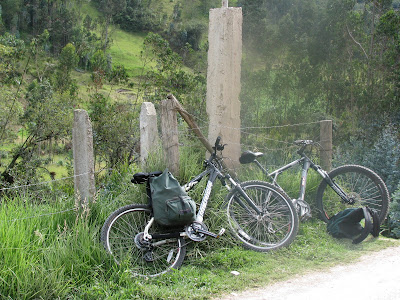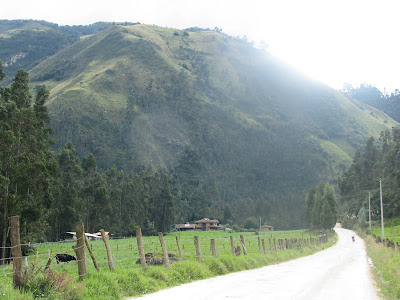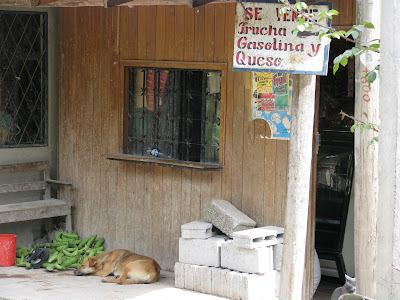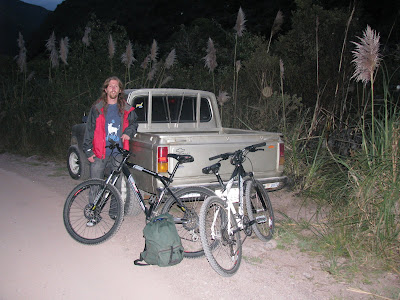
During the holidays my friend Jules, who I studied TOESL with in Mexico back in August, came down to Cuenca for a few days with his girlfriend. He got a job shortly after I did, working for a school in Quito, and as it turns out, his girlfriend has family here in my new hometown.
Over a few drinks one evening on Calle Larga, we made plans to go Cajas the next day. In Cajas, as you’ll see if you scroll down a few stories, I had a little run-in with some banditos in September. Despite that, Cajas is a great place to hike and I was ready for another trip.
So in the morning, myself, Jules, his girlfriend Alejandra, her brother Alvaro, and Alvaro’s son Pancho all made the drive up the hill to Cajas in Alvaro’s car. We hiked around quite a bit, had a good time, and then rewarded ourselves on the way back down the hill with some canelazos and trucha.
Trucha is trout, usually served whole and traditionally eaten down to the spine, leaving behind neither head nor tail, and in order to honor the tradition, I dutifully ate the head, which was crunchy on the outside and fatty on the inside, and the tail, which was like eating a fish-flavored potato chip.
My willingness to eat a fish from stem to stern may have also had something to do with the canelazo, which is a strong drink made from naranjilla fruit, a type of citrus somewhere between a lime and an orange in flavor, sugar, some water, and a fair quantity of aguardiente. Aguardiente is a liquor distilled from sugar cane, like rum. Except while good rum is distilled in quality wooden casks, I think aguardiente might be aged in plastic jugs and it sells for pennies an ounce. That said, canelazo is a tasty and wholesome beverage as mixed drinks go, it’s served hot, and presented tastefully in a ceramic decanter. This batch was a particularly strong one.
By the time we were done with lunch we were even more enthusiastic than when we began, and decided it was time for some hot springs. Our original plan was to go to Bagnos de Cuenca, a resort village south of town, but Alvaro claimed to know of some wild hot springs on the other side of the mountains to our south from Cajas. Well fortified (and yet still road worthy, for those of you concerned), we made our way along a long dirt road to the promised springs, which were there indeed, and were excellent, set deep in a green valley with sheer, lush mountains on either side.
We made our way home that night and already I was plotting my return trip to those springs. A couple of weeks later, I went for it, by bike.
I managed to persuade my friend James, another professor at CEDEI, to come along as well. We set off one Saturday afternoon, James having borrowed a bike from a friend and me on the one I bought a few months ago. James, while sharing my enthusiasm for mountain biking, enjoys downhill a lot more than uphill (who doesn’t, right?), and was probably a little surly after our first trip up a very steep hill outside of Cuenca. He was surlier still after it turned out we went up that hill for nothing, having taken a wrong turn. But what can I say, I’d had a few to drink the last time and was a little fuzzy on the directions. Fortunately for our morale, the ride back down that same hill was a lot of fun and got us back on track.
Properly oriented now on the scenic dirt road to the hidden springs, we enjoyed a leisurely ride without too many intense ups and downs. The road was, in my view, the perfect country bike ride, reasonably well maintained, very little traffic, and lightly peppered with dwellings interspersed amidst some incredibly beautiful countryside:
In this gently sloping valley, I found the homes and other buildings to be as interesting as the countryside.
This store, for example, features many of the qualities I appreciate in an Ecuadorian country tienda, and what will always be missing from corporate America: a pile of bananas, the ubiquitous sleeping dog, and a sign advertising the most attractive options available for sale, in this case, the mixed assortment of trout, gasoline and cheese. That’s a sales strategy with heart.
But, now is not the time for my philosophy on economics. Because, shortly after this picture was taken, my idyllic outpourings of appreciation for my pastoral surroundings began to be increasingly interrupted by James’ more pragmatic insistence: “So, how much further is it to these springs we’re heading for?”
You see, we left for our ride, as I mentioned before, in the early afternoon. What with a wrong turn and with what was perhaps a gross underestimation of the length of the journey by the author (which may or may not have also been due to my liberal self-administering of canelazo the last time around), we were an undisclosed distance from our goal, a few hours away from home, and with the evening already showing signs of setting in. Worse still, the common sight of evening storm clouds was also looming over our heads.
As some readers have learned from previous outdoors experiences with me, I possess what could be described as an unrealistically optimistic view towards country travel. On foot, by bike, in motor vehicles, I often view the open road as neverending and full of good times ahead. As a result, such details as food, warm clothes, the onset of darkness, for example, have arguably been downplayed in my mind from time to time during my consideration of a given journey. The years and the experiences they’ve offered me have taught me a lot about this sort of thing, and have taught a thing or two about me to my traveling companions at the same time. Today, as fate would have it, was one of those kinds of life experiences.
After some deliberation, James and I agreed to flag down the next passing vehicle regardless of the direction it was heading. As it turned out, it happened to be a truck heading towards the springs and our goal, driven by three teenage boys. They very agreeably not only told us their estimation of the distance we still had to cover (which, in the end, was on par with my own optimistic, and inaccurate appraisal), but offered us a ride as well. So we threw our bikes in the back of their truck, jumped back there ourselves and went for a ride.
20 minutes or so of driving at high speed on the bumpy dirt road got us to our destination, which turned out to be theirs as well. By bike, that amount of ground would’ve been traveled in just over an hour or so, at which point dusk would have firmly settled in. Luckily for us, these kids were on a fishing trip on the river that flowed along next to the hot springs and were stopping to fish more or less where we were stopping to soak. Even more luckily, they all lived in Cuenca and were willing to give us a ride back to town as well. So while they went fishing, we spent the next hour relaxing before one last high-speed downhill bike ride before dark, back to where they parked their truck.
The teenagers thought it was great to have a couple of gringos in the truck with them for their ride back to town, and we proved to be entertainment enough to warrant a free ride. Not to mention that they were genuinely buena gente. As much as we offered to pay them, they refused, and even gave us a ride downtown just a few blocks from our respective homes. Once, on the hour-long, dark, rainy ride back down the hill towards town, they shut off the headlights of the truck to show us what a ride home on a bike at night would’ve been like. Needless to say, we couldn’t see a damn thing. No moon, storm clouds, nothing like a street light for miles at a time.
As I may have mentioned before in my writing, I generally view the idea of thinking about how things might have been different as a waste of time. After all, reality works out the way it does and no other way, and we have only to reflect on what has happened to decide how to act in the future, rather than spend our precious time on earth dwelling on the impossible past. Nonetheless, an idulgence: had we not run into those kids, we probably would’ve ridden ahead a little longer, gotten discouraged, and started riding home. In which case we would’ve missed the springs, and probably gotten caught in the rain and the dark for at least part of our journey home, had we not broken down and decided to hole up under some awning somewhere in the middle of the night out there in the country.
But, life had another plan for us that day, and it’s an understatement to say that we were incredibly lucky to have flagged down a car full of nice teenagers going to the same place we were headed, and returning to the same place we came from. I mentioned at the beginning of this story about Cajas and the three teenagers who threatened us and did everything in their power to rob us. This day on the road to some wild hot springs, three teenagers managed to take what could have been a trying time and managed to work it out to be as close to a best-case scenario as I can think of. I could spend hours of your time reflecting over the forces of the universe that have the power to drive a day in your life into the realm of the truly remarkable, for better or for worse. But for now, let’s suffice it to say that I’m thankful for the way that things went.

Brian Horstman is a teacher of English as well as a traveler, writer, photographer and cyclist. His interest in traveling around Latin America began while he was living in New Mexico, where he began to experience the Latino culture that lives on there. From there he spent time in Oaxaca, Mexico and has since been living in Cuenca, Ecuador and will be living in Chile starting in 2011. Cal’s Travels chronicles some of his more memorable experiences from Mexico and Ecuador, as well as some side trips to other parts.











